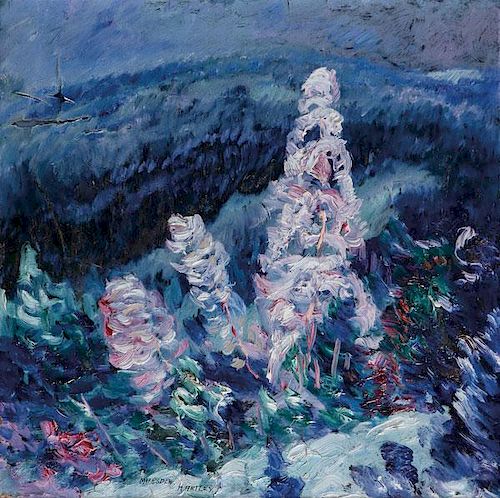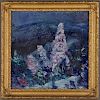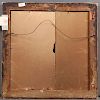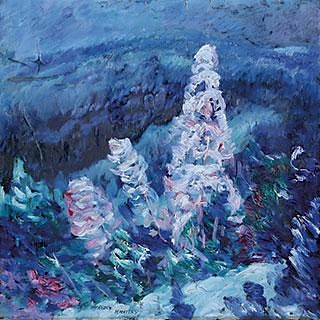MARSDEN HARTLEY OIL PAINTING - NOTMAN COLLECTION
About Seller
2229 Lincoln Street
Cedar Falls, IA 50613
United States
Founded in 1969, Jackson’s International Auctioneers and Appraisers has grown to become one of the nation’s premier service providers for the sale and appraisal of antiques and fine art. Our regularly scheduled auctions bring to market a broad array of objects, including Russian icons, Old Master pa...Read more
Two ways to bid:
- Leave a max absentee bid and the platform will bid on your behalf up to your maximum bid during the live auction.
- Bid live during the auction and your bids will be submitted real-time to the auctioneer.
Bid Increments
| Price | Bid Increment |
|---|---|
| $0 | $10 |
| $100 | $25 |
| $500 | $50 |
| $1,000 | $100 |
| $2,000 | $200 |
| $5,000 | $500 |
| $10,000 | $1,000 |
About Auction
Jun 27, 2017 - Jun 28, 2017
Jackson's International Auctioneers and Appraisers accounting@jacksonsauction.com
- Lot Description
MARSDEN HARTLEY(American 1877-1943)
Songs of Winter - circa 1908
Oil on card laid on board
Signed lower left of center
12 inches x 12 inches, contained in the original simple press molded gilt frame with partial label of New York frame maker George F. Of
Provenance:
Alfred Stieglitz Photo-Secession Gallery, New York, presumably the exhibition of March 1910 where acquired by George and Katherine Notman and subsequently descended through the family.
Exhibited:
The Photo-Secession Gallery, 291 Fifth Avenue, New York, March 1910. The Brooklyn Daily Eagle edition of March 15, 1910, page 8 under the heading 'The Art Calendar', lists the following: "Photo-Secession Club, 291 Fifth Avenue, Manhattan-Exhibition by Eduard Steichen, Arthur B. Charles, Marsden Hartley, John Marin, Alfred Mauer and others."
Comparison:: See: Christie's New York sale of December 5, 2013, Lot #26 depicting a very similar winter landscape titled Song of Winter, dated to circa 1908 and measuring 9.25 inches x 12 inches. Additionally, see the Metropolitan Museum of Art, New York, Song of Winter, No. 6, dated to circa 1908-1909 and measuring 8.75 inches x 11.8 inches, accession number 1996.13.5.
According to Elizabeth Finch, writing on the early works of Hartley in the book Marsden Hartley's Maine, Yale University Press, 2017, page 57, "The grouping of seasonal themes into "songs" signaled their association with Whitman's "Song of Myself". Another painting from this period, Proud Music of the Storm, also derives from Whitman. The coding of self in terms of nature (and Whitman) reverberates in the paint facture. Shades of blue tinged with pink predominate in the Songs of Winter series, and the subtle variation of loosely applied paint denotes both subject matter and the suggestion of distance or proximity."
The Notman Art Collection
In this modern age of digitalization and instant online access to old books, publications, inventories, sales records and the like, it might be hard to imagine that there still existed somewhere a heretofore unknown important collection of art located in the very heartland of America-Iowa. Yet such is precisely the case of the Notman art collection whose works have inconspicuously remained together in the same family for three generations never having been published or publicly displayed since they were first acquired well over a century ago.
The offered collection, which consists of a total of 55 works, features paintings by some of the most prominent American artists such as Marsden Hartley (American 1877 – 1943), John Marin (1870-1953), Samuel Colman (1832-1920) as well as others, and each having been acquired directly from the artist or through a gallery representing the artist in his or her lifetime.
To understand the collection and how it came to be, one must first go back in time to what Americans call the Gilded Age or what the French popularly referred to as La Belle Époque or the Beautiful Era. Indeed it was in this beautiful era in which many of the great American collections were assembled by patrons of the arts such as the Notman’s and subsequently went on to become the foundation of many a prominent museum’s collections. It was then this generation which so well understood that as a culture we are defined by the arts and as such it was in their very nature (as formed by their environment) to patronize them. Yet now, at the dawn of the 21st century, it seems truly amazing to see such a wonderful collection as the Notman’s, assembled so many years ago, be unveiled to the public and enter the market.
One could say that the story of the collection really begins in Edinburgh, Scotland with the birth of Peter Notman in the year 1820. Together with his older brother, John (1810-1865), like many of their day in the ‘old country,’ they set sail for America in 1834 to seek their destiny. Both first settled in Philadelphia, Pennsylvania where John would go on to achieve great notoriety as an architect. Whereas, Peter would become engaged in the insurance industry and eventually move from Pennsylvania to New York and rise to the presidency of the Niagara Fire Insurance Company and Sanborn Publishing. In 1850, Peter Notman (1820-1893) married Jane C. Dunlop (1829-1905) of West Chester, Pennsylvania, and together they had five sons and two daughters. It was their second son, George Notman (1853-1929) together with his wife Katherine (1859-1946), who would build the collection now being offered at auction.
George Notman was born in the affluent residential neighborhood of Brooklyn Heights into the well to do family of Peter Notman in the year 1853. In 1880, he married Brooklyn native Katherine Howard whose mother (Pamela Colman) was the sister of noted American artist Samuel Colman (1832-1920) and who is represented in this collection by 17 paintings. George Notman would make his way to the top of the American copper mining industry, eventually rising to become the secretary and treasurer of the Phelps-Dodge Corporation, a position he held for over four decades. In 1885, George and Katherine built a magnificent summer residence in the Keene Valley (Adirondacks) New York named Eaglestowe which remains in the family to this day. Katherine, who attended the Packer Collegiate Institute in Brooklyn, studied music under Joseph Mosenthal (1834-1896) and was a noted leader in the New York state Suffragist Movement. Together they had three children, sons Howard (1881-1964) who would become an artist in his own right, Arthur (1882-1961), and daughter Winifred (1890-1979).
It would appear that the first foray into collecting art by George and Katherine Notman began in earnest in 1903 at an auction held by the American Art Galleries in New York. A New York Times newspaper article dated March 26, 1903 (page 9) begins with the headline "SALE OF COLMAN PAINTINGS – Artist’s Own Pictures and His collection of Other Canvases Bring $22,275.00 at Auction." Interestingly, the article goes on to list each of Colman’s paintings by medium and title followed by the successful buyer. Additionally the American Art Annual, 1903-1904 edition (Vol. IV), also records the sale, by lot, title, size and buyer’s last name. A total of 17 paintings by Samuel Colman (the uncle of Katherine Notman) are listed as selling to the Notman’s and of which 8 are offered now at Jackson’s. One of the paintings acquired by the Notman’s at the 1903 auction, a large oil on canvas measuring 32 x 72 inches and titled, Kanawha River Valley, was donated by the Notman’s daughter (Mrs. David C. Prince-Winifred) and daughter-in law (Mrs. Arthur Notman) to the Smithsonian American Art Museum in 1968, collection number 1968.111.
Both of the Marsden Hartley paintings offered were likely acquired at the gallery of American photographer and modern art promoter Alfred Stieglitz (1864-1946). Stieglitz’s Little Galleries of the Photo-Secession (also known as gallery 291-a reference to the address on Fifth Avenue) was one of the first galleries to exhibit modern art in America. The offered paintings (Autumn Maine Landscape and Song of Winter Landscape) would seem to correspond to a group of paintings exhibited by Hartley in May of 1909 from a series titled Songs of Autumn and Songs of Winter.
The likely connection with the Notman’s and Stieglitz’s gallery was the relationship between Katherine Notman and artist Pamela Colman Smith (1878-1951), who were first cousins as well as nieces of artist Samuel Colman. In 1907, Alfred Stieglitz gave Pamela Colman Smith an exhibition of her paintings in New York at his Little Galleries of the Photo-Secession making Smith the first painter to have a show at what had been until then a gallery devoted exclusively to the photographic avant-garde. Stieglitz was intrigued by Smith's synesthetic sensibility; in this period, Smith would paint visions that came to her while listening to music. The show was successful enough that Stieglitz issued a platinum print portfolio of 22 of her paintings and showed her work twice more, in 1908 and 1909. It was the year of her last show there (1909) which corresponds with the time period of exhibitions of Marsden Hartley’s and John Marin’s works now offered for sale at this auction. Another possible connection between the Notman family and Stieglitz is the Notman’s relationship (albeit distant) to the noted Scottish born Canadian photographer, William Notman (1826-1891), who had a studio in New York and whose work was known by Stieglitz.
Both of the Hartley’s in the Notman collection remain in what are most certainly their original frames by George F. Of, a noted New York frame maker who it is well known to have worked closely with Stieglitz and the modernist artist he exhibited. Of the five John Marin (1870-1953) watercolors being offered from the Notman collection, three retain their original “Photo-Secession” gallery label and all would appear to be referenced in Sheldon Reich’s catalogue Raisonne on John Marin. Additionally they too, with the exception of one, are contained in frames by George F. Of.
Also included in the Notman collection are watercolors by Robert Swain Gifford (1840-1905) – a founding member of the American Watercolorist Society, as well as Charles Louis Mozin (1806-1862), Paul Marny (1829-1914), oils by Adirondacks painter George C. Parker (1862-1934) and drypoint etchings by Paul Cesar-Helleu (1859-1927) and Whistler. Additionally, a few pieces of decorative arts will also be offered including three southwest Native American pieces collected by Notman’s when visiting the copper mines in Arizona that his firm managed, as well as a piece of Tiffany and some American art pottery.
The collection now being offered made its way to Iowa from Brooklyn via the son of Arthur Notman (1882-1961), John Hancock Notman (1919-2006), who moved to Clinton, Iowa in 1949 where he would eventually become the general manager of the Clinton Herald Newspaper and the Trenton (NJ) Times Newspaper. His wife Gertrud (née Genske) of 57 years, died in Clinton in the year 2015.
Jackson's International is indeed honored to present this wonderful collection to a generatioSn of new art enthusiasts.SHIPPING NOTICE:
Jackson’s is your sole and only source for one stop packing and shipping. With over 50 years of experience, our professional, affordable and efficient in-house shipping department will be happy to provide you a fair and reasonable shipping quote on this lot. Simply email us before the auction for a quick quote: shipping@jacksonsauction.com or call 1-800-665-6743. Jackson’s can expertly pack and ship to meet any of your needs. To ensure quality control Jackson’s DOES NOT release to third party shippers. - Shipping Info
-
All successful absentee bidders may request a shipping quote for Jackson’s International to provide shipping to be sent with their invoice. This shipping quote includes the cost of standard shipping as well as charges for materials and labor. Please indicate any special shipping instructions on the bid form. Purchases paid by personal check will not be shipped until funds have cleared Auctioneer's bank. Please note that International shipping is not available for ivory items. These items will only be shipped within the United States, except to California, Connecticut, New Jersey, and New York. All buyers agree to comply with any additional restrictions regarding the trade of endangered species as a condition of sale. It is the purchaser’s responsibility to obtain any licenses and/or certificates as well as any other required documentation prior to shipment. In the case of denial or delay of any required documentation or paperwork, they buyer will still be responsible for making on-time payment for the total purchase price of the lot. Therefore, if you are unsure, Jackson’s recommend that you DO NOT BID on ivory items. We support the ban on the sale of non-antique carved ivory objects of art.
-
- Buyer's Premium



 EUR
EUR CAD
CAD AUD
AUD GBP
GBP MXN
MXN HKD
HKD CNY
CNY MYR
MYR SEK
SEK SGD
SGD CHF
CHF THB
THB















